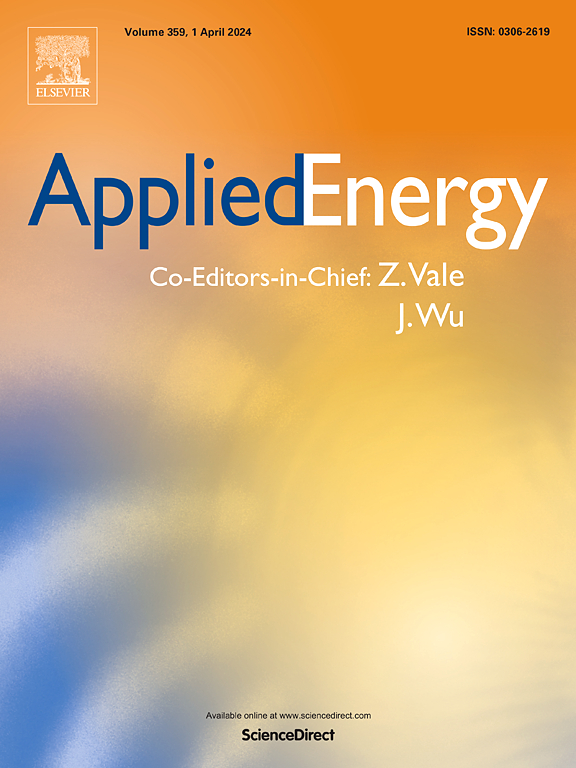Using Mobile soft open points to enhance power balance capability between LVDNs through mobility multi-stage optimization
IF 11
1区 工程技术
Q1 ENERGY & FUELS
引用次数: 0
Abstract
The flexible AC/DC interconnection of low-voltage distribution networks (LVDNs) using soft open points (SOPs) enhances load-carrying capacity and distributed generation (DG) accommodation capability through optimal power shifting considering the power complementarity between LVDNs. However, the degree of power complementarity of interconnected LVDNs is usually affected by the periodic change of load power, and the current fixed flexible AC/DC interconnection scheme plays a significant role only during some periods, resulting in a low utilization rate of flexible interconnection equipment. To tackle this issue, mobile soft open points (MSOP) are proposed to be used, which are vehicle-mounted SOPs with lightweight and can be installed/removed between LVDNs to achieve flexible interconnection. This paper proposes a multi-stage optimization method for scheduling MSOP. Firstly, the complementary characteristics and benefits of different LVDNs at various time scales in mobile flexible interconnection scenarios are analyzed quantitatively. Secondly, a nonlinear model is developed to assess the comprehensive moving cost of MSOP, taking into account the processes of removal, transportation and installation. Then, the mobility multi-stage optimal scheduling method for MSOP is proposed to enhance the intermittent power complementary capability and utilization capability of SOPs. Finally, the simulation results show that the proposed method enables intermittent power exchange between multi-zone LVDNs through the mobile and flexible interconnection of MSOP to overcome the spatial interconnection limitations of fixed SOPs. It effectively addresses the short-term overloading issues in low-voltage distribution networks caused by the temporal and spatial mismatch between generation and load, enhances the power balancing capability between LVDNs, and simultaneously improves the economic efficiency of LVDNs and the utilization rate of SOPs, laying a foundation for future smart grid interconnection strategies.
利用移动软开放点,通过移动性多级优化,增强lvdn之间的功率平衡能力
低压配电网采用软开路点(SOPs)实现交直流柔性互联,考虑到低压配电网之间的电力互补性,通过最优的功率转移,提高了电网的承载能力和分布式发电(DG)容纳能力。然而,互联lvdn的功率互补程度通常会受到负载功率周期性变化的影响,目前固定的柔性交流/直流互联方案仅在某些时期发挥重要作用,导致柔性互联设备利用率较低。为了解决这个问题,我们提出了移动软开放点(MSOP),这是一种轻量级的车载软开放点,可以在lvdn之间安装/移除,实现灵活的互联。提出了一种多阶段优化调度MSOP的方法。首先,定量分析了移动灵活互联场景下不同时间尺度lvdn的互补特性和效益。其次,建立了考虑搬迁、运输和安装过程的MSOP综合搬迁成本的非线性模型。在此基础上,提出了MSOP的机动性多阶段优化调度方法,提高了MSOP的间歇性电力互补能力和利用能力。仿真结果表明,该方法通过MSOP的移动灵活互联实现了多区域lvdn间的间歇性功率交换,克服了固定sop的空间互联限制。有效解决了因发电与负荷时空不匹配导致的低压配电网短期过载问题,增强了lvdn之间的功率均衡能力,同时提高了lvdn的经济效率和sop的利用率,为未来的智能电网互联策略奠定了基础。
本文章由计算机程序翻译,如有差异,请以英文原文为准。
求助全文
约1分钟内获得全文
求助全文
来源期刊

Applied Energy
工程技术-工程:化工
CiteScore
21.20
自引率
10.70%
发文量
1830
审稿时长
41 days
期刊介绍:
Applied Energy serves as a platform for sharing innovations, research, development, and demonstrations in energy conversion, conservation, and sustainable energy systems. The journal covers topics such as optimal energy resource use, environmental pollutant mitigation, and energy process analysis. It welcomes original papers, review articles, technical notes, and letters to the editor. Authors are encouraged to submit manuscripts that bridge the gap between research, development, and implementation. The journal addresses a wide spectrum of topics, including fossil and renewable energy technologies, energy economics, and environmental impacts. Applied Energy also explores modeling and forecasting, conservation strategies, and the social and economic implications of energy policies, including climate change mitigation. It is complemented by the open-access journal Advances in Applied Energy.
 求助内容:
求助内容: 应助结果提醒方式:
应助结果提醒方式:


